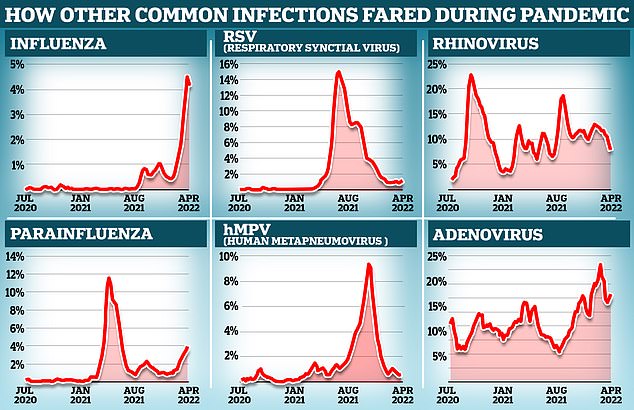Another viral cover-up or the effects of China’s draconian lockdowns? Everything we know about the mystery pneumonia surge that Beijing hid for five MONTHS
The eyes of the world are once again on China as the country suffers another mysterious respiratory outbreak that is overwhelming hospitals.
Chaotic scenes of mask-wearing crowds in Beijing hospitals have eerie echoes of the early days of the Covid outbreak four years ago, which also started with “undiagnosed pneumonia.”
Chinese authorities insist they are simply dealing with a resurgence of severe flu and respiratory diseases that have been suppressed by lockdown measures, and not a new virus like the one that caused the Covid-19 pandemic.
China had the longest and toughest lockdown measures in the world and is only now experiencing its first winter without these measures in years. The curbs are believed to have suppressed the immunity of the population and made them vulnerable to seasonal diseases.
While Chinese officials said they have no evidence of “unusual or new” pathogens, Obama’s ex-White House chief of staff Rahm Emanuel has said Beijing’s history of cover-ups raises skepticism.
Chinese officials have insisted that no new pathogen is to blame, instead blaming a rise in common winter bugs as the country faces its first full winter without anti-Covid measures.

Rahm Emanuel, formerly President Barack Obama’s White House chief of staff, recently said there are still “serious questions” about the recent pneumonia outbreak in China
People first became aware of the current virus outbreak on November 21, when an international disease surveillance system called ProMED published an alert on reports of “undiagnosed pneumonia.”
ProMED works to identify unusual health events associated with emerging infectious diseases. The monitoring system is based on a global network of healthcare experts who look for health announcements and tips, social media discussions, health department announcements and local media reports.
When it alerted the public last week following a local media report, there were immediate comparisons to the 2019 Covid-19 outbreak.
ProMED was the first to raise the alarm in December 2019 about the emergence of a new ‘undiagnosed pneumonia’ in Wuhan, which later turned into the Covid-19 pandemic.
As in 2019, it was left to independent health authorities and not China itself to report the current pneumonia outbreak.
The warning six days ago prompted the World Health Organization (WHO) to send an official request to Chinese authorities two days later asking for official data and information on the outbreak.
The WHO, which responded quickly and put pressure on China, is still reeling from criticism that it was protecting China and echoing the country’s official line from China that Covid could not spread among people, despite there being no evidence to support this claim supported.

People first became aware of the current virus outbreak on November 21, when the public disease surveillance system ProMED published an alert about reports of “undiagnosed pneumonia.”

ProMED, a global health surveillance system led by health experts, first raised the alarm over the emergence of a new ‘undiagnosed pneumonia’ in Wuhan, which later turned into the Covid-19 pandemic
Chinese authorities arranged a conference call with the WHO on Thursday to provide the requested data. The agency said the information provided indicated the clusters of cases were from known pathogens.
Although public and world health authorities only recently learned of the outbreak, the cases are believed to have occurred in May. The delay in reporting and lack of information on the number of cases and deaths once again raised concerns among Chinese history officials about a lack of transparency when it comes to public health events.
Local media said last week that the outbreak appears to be mainly affecting children and that some schools have had to cancel classes due to the high number of absences due to the disease.
But because of the delay in reporting, what the world learns could be distorted. Although China says the virus mainly affects children, the ambiguity is eerily consistent with initial claims that Covid-19 has spread among people.
Chinese and global health officials say the surge is not unusual for this time of year and that excessive lockdowns have ruined children’s immunity due to the lack of social interaction, leaving them susceptible to other potentially dangerous viruses.
A WHO official said the spike in respiratory diseases China is currently experiencing is not as high as before the COVID-19 pandemic.
The official also reiterated that no new or unusual pathogens had been found in the recent cases.

MailOnline has analyzed the percentage of people who tested positive for flu, rhinovirus, parainfluenza, RSV, hMPV and adenovirus in England during the pandemic. Rates for all viruses except rhinovirus were higher in April 2022 than in the same period the year before, when people were only allowed to meet in groups of six, working from home was still in place and hugging was still discouraged
Maria Van Kerkhove, acting director of the WHO’s Epidemic and Pandemic Preparedness and Prevention Unit, said this weekend that the increase appears to be driven by a rise in the number of children contracting pathogens where they have been exposed by two years of COVID restrictions kept away from him.
“We asked about comparisons before the pandemic. And the waves they see now, the peak is not as high as what they saw in 2018-2019,” Van Kerkhove told STAT.
She added: ‘This is not indicative of a new pathogen. This is expected. This is what most countries faced a year or two ago.”
Chinese National Health Commission spokesperson Mi Feng echoed these sentiments on Sunday, saying the increase in acute respiratory diseases was related to the simultaneous circulation of different types of pathogens, especially influenza.
What could be reassuring, however, are the images coming out of China. During the pandemic, photos of bodies piling up, overwhelmed intensive care units and overcrowded funeral homes sparked fear in the international community as China failed to keep up with the rapidly growing number of deaths.
Photos of overcrowded hospitals are emerging this week, but they do not show the same dire situation the country faced during the peaks of the pandemic.
China would not be the first country to suffer the consequences of lockdowns during the pandemic.
England saw a similar increase in other diseases after lockdowns and iBy spring 2022, rates of some respiratory illnesses in the country were 20 times higher than after the first shutdown of 2020.
Data from April 2022 showed that flu cases were four times higher compared to July 2020, when social distancing restrictions were still in place across much of the world.
